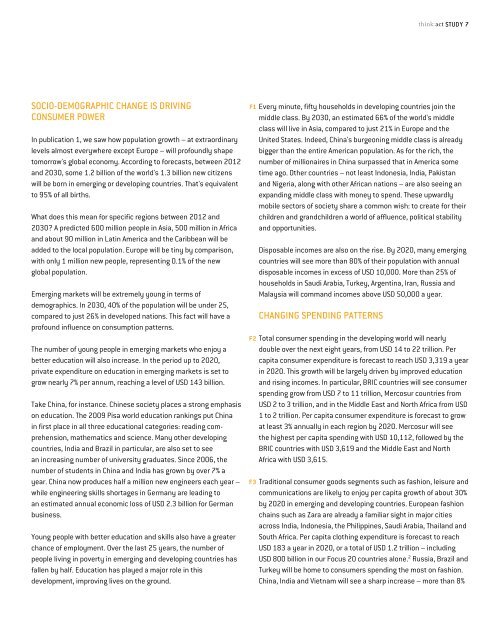How to reach emerging market consumers with new ... - Roland Berger
How to reach emerging market consumers with new ... - Roland Berger
How to reach emerging market consumers with new ... - Roland Berger
You also want an ePaper? Increase the reach of your titles
YUMPU automatically turns print PDFs into web optimized ePapers that Google loves.
Study 7<br />
Socio-demographic change IS DRIVING<br />
consumer power<br />
In publication 1, we saw how population growth – at extraordinary<br />
levels almost everywhere except Europe – will profoundly shape<br />
<strong>to</strong>morrow's global economy. According <strong>to</strong> forecasts, between 2012<br />
and 2030, some 1.2 billion of the world's 1.3 billion <strong>new</strong> citizens<br />
will be born in <strong>emerging</strong> or developing countries. That's equivalent<br />
<strong>to</strong> 95% of all births.<br />
What does this mean for specific regions between 2012 and<br />
2030? A predicted 600 million people in Asia, 500 million in Africa<br />
and about 90 million in Latin America and the Caribbean will be<br />
added <strong>to</strong> the local population. Europe will be tiny by comparison,<br />
<strong>with</strong> only 1 million <strong>new</strong> people, representing 0.1% of the <strong>new</strong><br />
global population.<br />
Emerging <strong>market</strong>s will be extremely young in terms of<br />
demographics. In 2030, 40% of the population will be under 25,<br />
compared <strong>to</strong> just 26% in developed nations. This fact will have a<br />
profound influence on consumption patterns.<br />
The number of young people in <strong>emerging</strong> <strong>market</strong>s who enjoy a<br />
better education will also increase. In the period up <strong>to</strong> 2020,<br />
private expenditure on education in <strong>emerging</strong> <strong>market</strong>s is set <strong>to</strong><br />
grow nearly 7% per annum, <strong>reach</strong>ing a level of USD 143 billion.<br />
Take China, for instance. Chinese society places a strong em phasis<br />
on education. The 2009 Pisa world education rankings put China<br />
in first place in all three educational categories: reading comprehension,<br />
mathematics and science. Many other develo ping<br />
countries, India and Brazil in particular, are also set <strong>to</strong> see<br />
an increasing number of university graduates. Since 2006, the<br />
number of students in China and India has grown by over 7% a<br />
year. China now produces half a million <strong>new</strong> engineers each year –<br />
while engineering skills shortages in Germany are leading <strong>to</strong><br />
an estimated annual economic loss of USD 2.3 billion for German<br />
business.<br />
Young people <strong>with</strong> better education and skills also have a greater<br />
chance of employment. Over the last 25 years, the number of<br />
people living in poverty in <strong>emerging</strong> and developing countries has<br />
fallen by half. Education has played a major role in this<br />
development, improving lives on the ground.<br />
f1 Every minute, fifty households in developing countries join the<br />
middle class. By 2030, an estimated 66% of the world's middle<br />
class will live in Asia, compared <strong>to</strong> just 21% in Europe and the<br />
United States. Indeed, China's burgeoning middle class is already<br />
bigger than the entire American population. As for the rich, the<br />
number of millionaires in China surpassed that in America some<br />
time ago. Other countries – not least Indonesia, India, Pakistan<br />
and Nigeria, along <strong>with</strong> other African nations – are also seeing an<br />
expanding middle class <strong>with</strong> money <strong>to</strong> spend. These upwardly<br />
mobile sec<strong>to</strong>rs of society share a common wish: <strong>to</strong> create for their<br />
children and grandchildren a world of affluence, political stability<br />
and opportunities.<br />
f2<br />
f3<br />
Disposable incomes are also on the rise. By 2020, many <strong>emerging</strong><br />
countries will see more than 80% of their population <strong>with</strong> annual<br />
disposable incomes in excess of USD 10,000. More than 25% of<br />
households in Saudi Arabia, Turkey, Argentina, Iran, Russia and<br />
Malaysia will command incomes above USD 50,000 a year.<br />
Changing spending patterns<br />
Total consumer spending in the developing world will nearly<br />
double over the next eight years, from USD 14 <strong>to</strong> 22 trillion. Per<br />
capita consumer expenditure is forecast <strong>to</strong> <strong>reach</strong> USD 3,319 a year<br />
in 2020. This growth will be largely driven by improved education<br />
and rising incomes. In particular, BRIC countries will see consumer<br />
spending grow from USD 7 <strong>to</strong> 11 trillion, Mercosur countries from<br />
USD 2 <strong>to</strong> 3 trillion, and in the Middle East and North Africa from USD<br />
1 <strong>to</strong> 2 trillion. Per capita consumer expenditure is forecast <strong>to</strong> grow<br />
at least 3% annually in each region by 2020. Mercosur will see<br />
the highest per capita spending <strong>with</strong> USD 10,112, followed by the<br />
BRIC countries <strong>with</strong> USD 3,619 and the Middle East and North<br />
Africa <strong>with</strong> USD 3,615.<br />
Traditional consumer goods segments such as fashion, leisure and<br />
communications are likely <strong>to</strong> enjoy per capita growth of about 30%<br />
by 2020 in <strong>emerging</strong> and developing countries. European fashion<br />
chains such as Zara are already a familiar sight in major cities<br />
across India, Indonesia, the Philippines, Saudi Arabia, Thailand and<br />
South Africa. Per capita clothing expenditure is forecast <strong>to</strong> <strong>reach</strong><br />
USD 183 a year in 2020, or a <strong>to</strong>tal of USD 1.2 trillion – including<br />
USD 800 billion in our Focus 20 countries alone. 2 Russia, Brazil and<br />
Turkey will be home <strong>to</strong> <strong>consumers</strong> spending the most on fashion.<br />
China, India and Vietnam will see a sharp increase – more than 8%
















